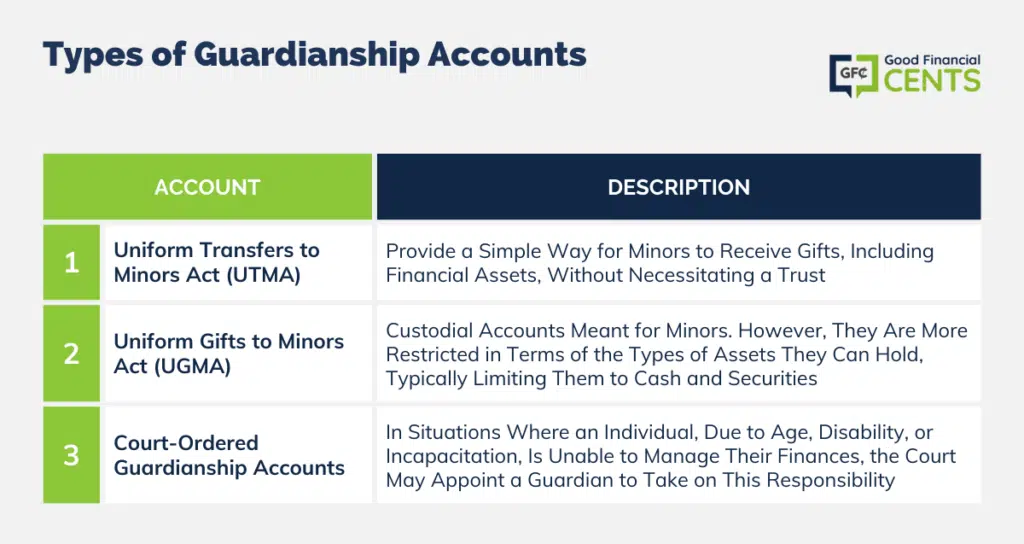Guardianship accounts play a critical role in safeguarding the financial interests of minors, senior citizens, and disabled individuals, requiring strict court oversight, transparent reporting, and prudent asset management from appointed guardians.
There comes a time when minors, senior citizens, or disabled persons might need someone to manage their money. In these cases, a guardian will be appointed by the court to control guardianship of the individual’s accounts.
While you want to think that everyone who is appointed a guardian of an account is trustworthy and will manage the accounts ethically and wisely, that is not always the case.
That is why there are rules governing the control of guardian accounts. From who has access to the account, to who owns it, and how money is spent, courts monitor these accounts.
Children and Guardianship Accounts
Children are not legally allowed to open a bank account or manage their own money in an account. Sometimes a parent or guardian might jointly open an account for a child to save money for college or to just help to teach the child about saving.
In this case, the parent is the actual owner of the account has control over the money, and may do what they wish with the funds.
This is different than a guardianship account. With a guardianship account, the money does belong to the child. The guardian of the account manages the money for a child but doesn’t have any ownership over that money.
The most common reason for a child to have an account with guardianship is that the parents are deceased and have left money or property for the child and someone, the guardian, needs to control that account until the child is of legal age.
Elderly or Disabled Individuals and Guardianship Accounts
Sometimes adults do not have the physical or mental capacity to manage their finances and a guardian needs to be appointed. As with children, the guardian does not gain any ownership of the person’s finances, they just manage the account.
The court chooses an appropriate guardian for someone who has been deemed unable to manage their finances.
Types of Guardianship Accounts
Guardianship accounts can be broadly categorized into several types, each serving specific needs and situations.
1. Uniform Transfers to Minors Act (UTMA) Accounts
UTMA accounts provide a simple way for minors to receive gifts, including financial assets, without necessitating a trust. The custodian, who could be a parent or a legal guardian, manages the account on behalf of the minor until they reach the age of majority.
2. Uniform Gifts to Minors Act (UGMA) Accounts
UGMA accounts, like UTMA accounts, are custodial accounts meant for minors. However, they are more restricted in terms of the types of assets they can hold, typically limiting them to cash and securities.
3. Court-Ordered Guardianship Accounts
In situations where an individual, due to age, disability, or incapacitation, is unable to manage their finances, the court may appoint a guardian to take on this responsibility. This type of guardianship account is strictly regulated to protect the interests of the individual in need.


The Rules and How It All Works
As mentioned, the guardian of an account controls the funds and must report all receipts and disbursements to the court on a periodic basis. The guardian handles the account but has no ownership of the account, meaning the money or property in the account.
- All guardianship accounts have a beneficiary or a “ward”, usually a child, elderly, or disabled individual.
- The guardian of the account cannot appoint a beneficiary of the account. In other words, the guardian cannot change who the account is for and who receives the disbursements.
- In order to open a guardianship account, the guardian must show a certified copy of a court order appointing them the guardian of an individual’s account.
- If an individual can no longer serve as guardian of an account, because of death or some other reason, the court will appoint a new guardian for the account.
- Because the guardian does not own the funds in the account, the money can not be used to settle the debt of the guardian – meaning it can’t be garnished or seized.
Duties and Liabilities of Guardians
The guardian’s role is pivotal, and it comes with a set of responsibilities and potential liabilities.
1. Prudent Asset Management
The guardian is expected to manage the assets prudently, making sound investment decisions to ensure the safety of the principal while also aiming for growth.
2. Transparent Reporting
Regular, transparent reporting to the court is crucial. The guardian must detail all receipts, and disbursements, and provide updates on the status of the investments.
3. Avoiding Conflicts of Interest
Maintaining a clear boundary between personal finances and the guardianship account is paramount. The guardian must avoid any investments or decisions that could potentially benefit them at the expense of the beneficiary.
4. Ensuring the Beneficiary’s Well-being
The guardian is tasked with using the assets in the account to cater to the beneficiary’s needs, following the guidelines and stipulations laid out by the court order.
Safeguarding the Beneficiary’s Interests
The system has built-in checks and balances to ensure the ethical management of guardianship accounts.
1. Strict Court Oversight
Courts play a critical role in monitoring guardianship accounts, ensuring regular reporting, and providing oversight to protect the beneficiary’s interests.
2. Clear Ownership Boundaries
The assets in the guardianship account belong solely to the beneficiary. The guardian has control but does not have any ownership rights, ensuring that the beneficiary’s interests are paramount.
Practical Aspects of Managing Guardianship Accounts
1. Opening and Closing Accounts
To initiate a guardianship account, the guardian needs to present a certified copy of the court order that appoints them as the guardian.
If a guardian is unable to continue their duties, or if the beneficiary reaches the age defined by the court for asset transfer, the court will intervene to either close the account or appoint a new guardian.
2. Protection from the Guardian’s Debts
The assets in a guardianship account are shielded from the guardian’s personal debts, ensuring that creditors cannot seize these assets.
3. Prohibition of Unilateral Decisions
Guardians are not allowed to change the beneficiary of the account or make decisions that serve their interests at the expense of the beneficiary.
Conclusion
Guardianship accounts are essential tools that play a crucial role in safeguarding the financial interests of minors, senior citizens, and disabled individuals.
Understanding the various types of guardianship accounts, along with the responsibilities, liabilities, and protections in place, is vital.
This ensures that the accounts fulfill their intended purpose, providing financial stability, support, and peace of mind for those who need it most.
By adhering to strict rules and maintaining transparency, we can uphold the ethical management of these accounts, ensuring that the assets are used solely for the benefit of the individuals they are meant to protect.


:max_bytes(150000):strip_icc()/Health-milk-recall-462d75ddea10415986c38d8da42d5f09.png)

